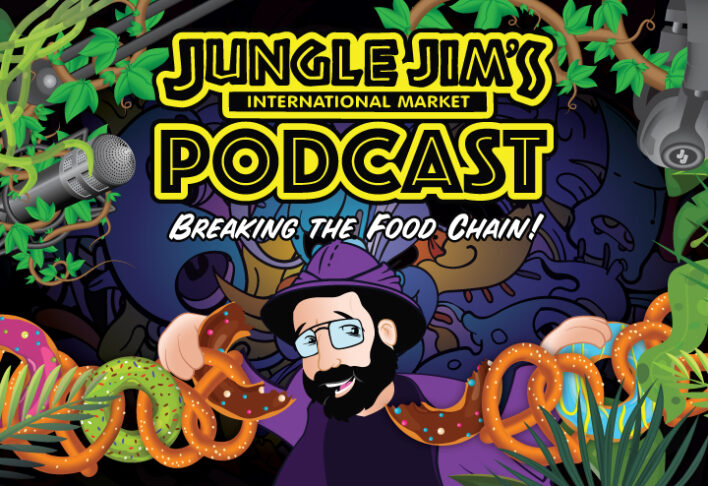
International
-
Discoveries at the Jungle Cookie Month!
Welcome to Discoveries at the Jungle, where each month we’ll take a look at some of the most interesting, flavorful and sometimes bizarre international items Jungle Jim’s has to offer. This month, we’re featuring cookies from around the world! So far this year we have focused on coffee, tea, snacks, pasta and candy, so if you missed those posts, make sure you go back and give them a read.- Posted: 6/3/2017
- Categories: Discoveries at the Jungle
Comments Off on Discoveries at the Jungle Cookie Month!Cookies, crisps, biscuits, wafers,
Read article -
Discoveries at the Jungle Candy Month: Toblerone Chocolate Bars from Switzerland and White Rabbit Creamy Candy from China
From chocolate, to fruity gummies and hard candy, to liquorice, caramels, marshmallows, taffy, and more, candy has been around for centuries. It comes in all shapes and sizes, too! But where did “candy” come from? Let’s take a look.- Posted: 5/13/2017
- Categories: Discoveries at the Jungle
Comments Off on Discoveries at the Jungle Candy Month: Toblerone Chocolate Bars from Switzerland and White Rabbit Creamy Candy from ChinaCandy can be traced back to the ancient Egyptians where they, along with the Chinese and Indians, combined fruits, nuts and honey to make sweets. Once sugar processing was discovered, though, it kickstarted a new candy industry.
Read article -
Discoveries at the Jungle Candy Month: Butlers Chocolate Bars from Ireland and Ritter Chocolate Bars from Germany
From chocolate, to fruity gummies and hard candy, to liquorice, caramels, marshmallows, taffy, and more, candy has been around for centuries. It comes in all shapes and sizes, too! But where did “candy” come from? Let’s take a look.- Posted: 5/11/2017
- Categories: Discoveries at the Jungle
Comments Off on Discoveries at the Jungle Candy Month: Butlers Chocolate Bars from Ireland and Ritter Chocolate Bars from GermanyCandy can be traced back to the ancient Egyptians where they, along with the Chinese and Indians, combined fruits, nuts and honey to make sweets. Once sugar processing was discovered, though, it kickstarted a new candy industry.
Read article -
Discoveries at the Jungle Candy Month: Lotte E. Wedel Chocolates from Poland and Wedgewood Walters Nougat Candy from South Africa
From chocolate, to fruity gummies and hard candy, to liquorice, caramels, marshmallows, taffy, and more, candy has been around for centuries. It comes in all shapes and sizes, too! But where did “candy” come from? Let’s take a look.- Posted: 5/8/2017
- Categories: Discoveries at the Jungle
Comments Off on Discoveries at the Jungle Candy Month: Lotte E. Wedel Chocolates from Poland and Wedgewood Walters Nougat Candy from South AfricaCandy can be traced back to the ancient Egyptians where they, along with the Chinese and Indians, combined fruits, nuts and honey to make sweets. Once sugar processing was discovered, though, it kickstarted a new candy industry.
Read article -
Discoveries at the Jungle Candy Month: Cote D’Or Chocolate from Belgium and Morinaga Hi-Chew Candy from Japan
From chocolate, to fruity gummies and hard candy, to liquorice, caramels, marshmallows, taffy, and more, candy has been around for centuries. It comes in all shapes and sizes, too! But where did “candy” come from? Let’s take a look.- Posted: 5/6/2017
- Categories: Discoveries at the Jungle
Comments Off on Discoveries at the Jungle Candy Month: Cote D’Or Chocolate from Belgium and Morinaga Hi-Chew Candy from JapanCandy can be traced back to the ancient Egyptians where they, along with the Chinese and Indians, combined fruits, nuts and honey to make sweets. Once sugar processing was discovered, though, it kickstarted a new candy industry.
Read article -
Discoveries at the Jungle Candy Month: Nordic Sweets Gummy Candy from Sweden and Leone Candies from Italy
From chocolate, to fruity gummies and hard candy, to liquorice, caramels, marshmallows, taffy, and more, candy has been around for centuries. It comes in all shapes and sizes, too! But where did “candy” come from? Let’s take a look.- Posted: 5/4/2017
- Categories: Discoveries at the Jungle
Comments Off on Discoveries at the Jungle Candy Month: Nordic Sweets Gummy Candy from Sweden and Leone Candies from ItalyCandy can be traced back to the ancient Egyptians where they, along with the Chinese and Indians, combined fruits, nuts and honey to make sweets. Once sugar processing was discovered, though, it kickstarted a new candy industry.
Read article -
Discoveries at the Jungle Pasta Month: Bambino Pasta and Caridom Noodles
- Posted: 4/15/2017
- Categories: Discoveries at the Jungle
Comments Off on Discoveries at the Jungle Pasta Month: Bambino Pasta and Caridom NoodlesIt’s difficult to trace the origins of pasta, but it’s believed to have been invented around the 1st or 2nd century AD. Incredibly, It didn’t hit Italy until the 13th or 14th century! While you may think of Italy when you hear pasta, many cultures and countries around the world use pasta in their everyday dishes.
Pasta is typically made of dough that contains mostly wheat flour, but buckwheat, rye, rice and maize can be used as well,
Read article -
Discoveries at the Jungle Pasta Month: Conimex Pasta and Misko Pasta
- Posted: 4/12/2017
- Categories: Discoveries at the Jungle
Comments Off on Discoveries at the Jungle Pasta Month: Conimex Pasta and Misko PastaIt’s difficult to trace the origins of pasta, but it’s believed to have been invented around the 1st or 2nd century AD. Incredibly, It didn’t hit Italy until the 13th or 14th century! While you may think of Italy when you hear pasta, many cultures and countries around the world use pasta in their everyday dishes.
Pasta is typically made of dough that contains mostly wheat flour, but buckwheat, rye, rice and maize can be used as well,
Read article -
Discoveries at the Jungle Pasta Month: La Moderna Pasta and Wang Udon Kuk Soo
- Posted: 4/10/2017
- Categories: Discoveries at the Jungle
Comments Off on Discoveries at the Jungle Pasta Month: La Moderna Pasta and Wang Udon Kuk SooIt’s difficult to trace the origins of pasta, but it’s believed to have been invented around the 1st or 2nd century AD. Incredibly, It didn’t hit Italy until the 13th or 14th century! While you may think of Italy when you hear pasta, many cultures and countries around the world use pasta in their everyday dishes.
Pasta is typically made of dough that contains mostly wheat flour, but buckwheat, rye, rice and maize can be used as well,
Read article -
Discoveries at the Jungle Pasta Month: Excellent Rice Stick Bihon and Bechtle Pasta
- Posted: 4/8/2017
- Categories: Discoveries at the Jungle
Comments Off on Discoveries at the Jungle Pasta Month: Excellent Rice Stick Bihon and Bechtle PastaIt’s difficult to trace the origins of pasta, but it’s believed to have been invented around the 1st or 2nd century AD. Incredibly, It didn’t hit Italy until the 13th or 14th century! While you may think of Italy when you hear pasta, many cultures and countries around the world use pasta in their everyday dishes.
Pasta is typically made of dough that contains mostly wheat flour, but buckwheat, rye, rice and maize can be used as well,
Read article


